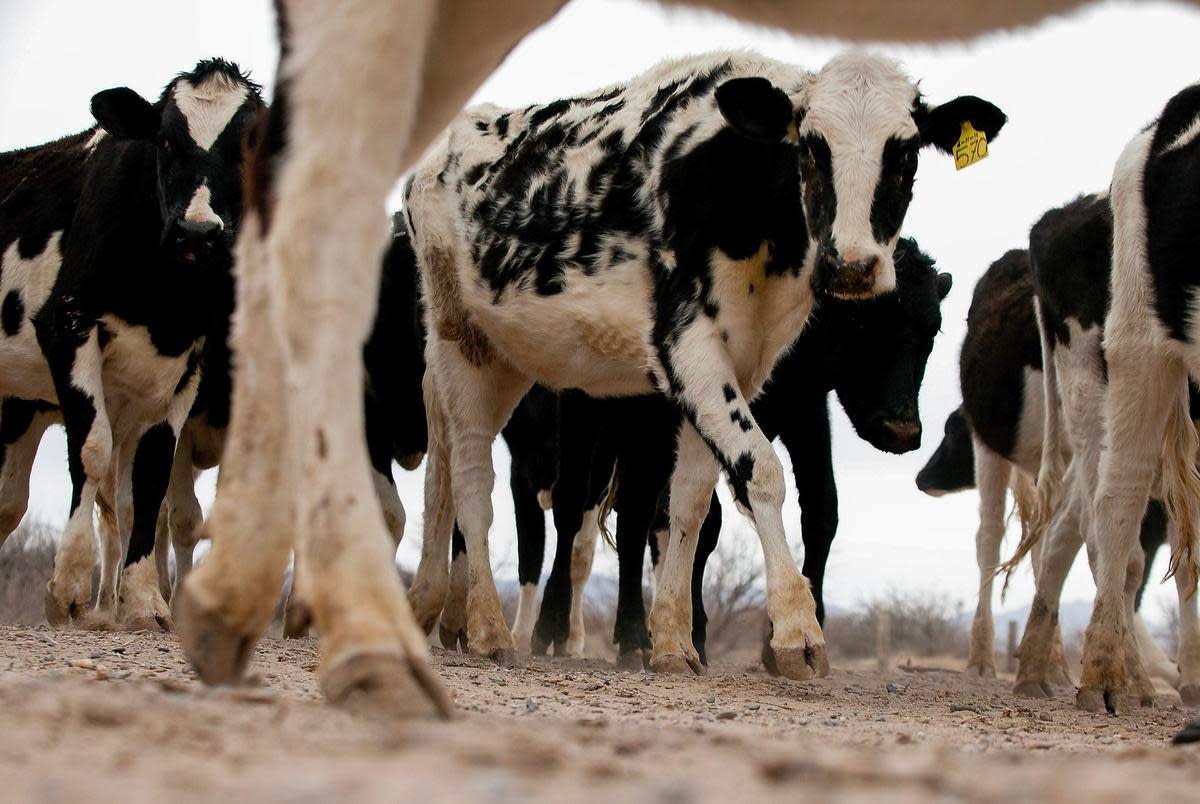Cows at two Texas dairy farms have bird flu, another blow to Cattle Country following wildfires

- Oops!Something went wrong.Please try again later.
LUBBOCK — Cows in the Texas Panhandle have tested positive for the bird flu, another blow to the Texas dairy industry following historic wildfires that killed at least 7,000 livestock.
The discovery, reported at two different dairies, is believed to be the first time the disease was found in livestock, researchers say.
Strains of Highly Pathogenic Avian Influenza, commonly known as the bird flu, were confirmed Monday by the U.S. Secretary of Agriculture and the Animal and Plant Health Inspection Service. The state agriculture department is also monitoring the outbreak. Similar outbreaks have been reported at dairies in Kansas and New Mexico.
The U.S. Department of Agriculture said there is no safety concern to the commercial milk supply. Consumer health is also not at risk, the department said. The milk from impacted animals is being dumped or destroyed and will not enter the food supply.
“In the rare event that some affected milk enters the food chain, the pasteurization process will kill the virus,” said Texas Agriculture Commissioner Sid Miller.
The dairy industry is critical for the state. With about 292 dairies and an estimated 625,000 cows, Texas ranks fourth in the U.S. when it comes to milk production, and contributes roughly $50 billion to the state’s economy. In the Panhandle, also known as Cattle Country, more than 1.3 billion gallons of milk are produced each year, according to data from the Texas Association of Dairymen. The highest rates of production are in Hartley, Castro and Moore counties.
According to the Texas Animal Health Commission, the disease is causing a decrease in milk production as well as thicker, colostrum-like milk and cows have less of an appetite. The disease is also severely impacting older cows and cows in mid-lactation. Infected herds are expected to lose up to 40% of their milk production for 7-10 days until they recover from their symptoms, Miller said.
On average, about 10% of each affected herd appears to be infected. The USDA did not specify if any cows have died from the disease. And experts say it can be difficult to track as dairies are also culling cattle for other reasons.
Milk loss from infected cows is “too limited” to have a major impact on supply.
“There should be no impact on the price of milk or other dairy products,” the USDA said in a statement.
Multiple agencies are working fast to monitor the affected herds and conduct additional testing. The disease moves quickly from bird to bird, but experts say the disease is uncommon for dairy herds.
“We have never seen avian influenza in dairy cows before,” said Erin Supak, director of communications for the animal health commission. “So we’re encouraging best management practices and enhanced biosecurity measures to be put in place and ensure the spread is not going to go farther than it already has.”
According to the USDA, the disease appears to have been introduced to the herds by deceased wild birds. The conclusion comes after farms reported finding the dead birds on their properties.
The animal health commission is working with the federal agriculture department and the Texas A&M Veterinary Medical Diagnostic Laboratory, as well as other agencies, to continue evaluating the situation. Experts are recommending to limit the number of people coming into dairies to employees and essential workers only, and to use biosecurity resources.
Supak says there are other signs for dairy producers to watch for including abnormal, tacky feces, low appetite and fever.
Dairy farmers and veterinarians are encouraged to report cattle illnesses to the USDA, state animal health commission or the Texas A&M lab, as the situation is ongoing. Initial testing by the National Veterinary Services Laboratories show the current risk to the public is low, as no changes in the virus have made it more transmissible to humans.
Disclosure: Texas Association of Dairymen has been a financial supporter of The Texas Tribune, a nonprofit, nonpartisan news organization that is funded in part by donations from members, foundations and corporate sponsors. Financial supporters play no role in the Tribune's journalism. Find a complete list of them here.
We can’t wait to welcome you to downtown Austin Sept. 5-7 for the 2024 Texas Tribune Festival! Join us at Texas’ breakout politics and policy event as we dig into the 2024 elections, state and national politics, the state of democracy, and so much more. When tickets go on sale this spring, Tribune members will save big. Donate to join or renew today.
Clarification, March 27, 2024 at 6:25 p.m. : This article has been updated to clarify the number of Texas dairies that have reported bird flu among its cattle after the Texas agriculture department corrected the number it publicly shared.

